Comptroller Kevin Lembo Archive > News
COMPTROLLER LEMBO SAYS LEGISLATIVE ACTION ELIMINATES $220-MILLION DEFICIT FOR NOWWARNS THAT FURTHER REVENUE EROSION IS POSSIBLE
Comptroller Kevin Lembo announced today that spending reductions and transfers adopted by the legislature this week provide the necessary tools to eliminate this fiscal year's $220-million deficit - however, he warned about possible further revenue erosion and other risks related to moderate national economic growth.
"Passage of the bipartisan deficit mitigation plan is a significant step forward in restoring budget stability -- however, there remain significant downside risks," Lembo said. "My greatest concern continues to be further erosion in General Fund revenue through the final months of Fiscal Year 2016.
"Specifically, while the withholding portion of the income tax showed solid growth in the month of March, it is still underperforming on a year-to-date basis. In addition, there has been some slippage in the sales tax trend, and national economic growth projections have moderated."
In a letter to Gov. Dannel P. Malloy, Lembo said there is continued risk of a downward trend in revenue and that it will be especially important to monitor the estimated and final payment tax collections in April.
"The estimated and final payment collections in April are especially important," Lembo said. "These receipts are highly dependent on capital gains and bonus payments to workers. This category of revenue has been exceptionally volatile over the past several decades and is difficult to project given the absence of timely Connecticut-specific data on the major factors driving collections in this area.
"Connecticut's economy continues to experience moderate growth, but is falling short of the growth required to support original budget estimates," Lembo said.
Lembo pointed to some of the latest economic indicators from federal and state Departments of Labor and other sources that show:

• Through March 28, year-to-date income tax withholding receipts were running
2.7 percent above the same period last fiscal year. New tax rate tables
incorporating the higher rate structure, as adopted in PA 15-244, were required
to be implemented by the end of August. Therefore, beginning in September 2015
receipts have incorporated the higher tax rates.
• Withholding receipts are the largest single source of state tax revenue,
accounting for 61 percent of the total income tax receipts in Fiscal Year 2015
and almost 40 percent of total General Fund tax receipts in that year. With the
exception of tax increase spikes in Fiscal Years 2011 and 2012, the current
cycle of economic recovery has posted below normal withholding gains.
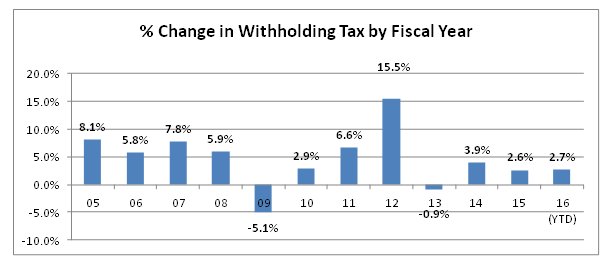
• The Department of Labor reported that the job growth originally posted during
2015 was revised significantly lower as a result of an updated benchmark
process. The 2015 annual average nonfarm employment growth was 12,200 payroll
positions as compared to the 26,900 reported pre-benchmark. The revised figure
is more in line with the observed growth in 2013 and 2014, and better explains
the lag in income tax withholding growth.
• The Department of Labor also released job numbers for February and revised
January job totals. Connecticut added 4,200 nonfarm jobs (0.25 percent) in
February 2016 to a level of 1,685,400, seasonally adjusted. In addition, January
2016's initial release of a 900-job gain was revised slightly higher to 1,200.
The state has now increased nonfarm employment by 15,800 positions (0.95
percent) over February 2015.
• Connecticut has now recovered 91,200 positions, or 76.6 percent of the 119,100
seasonally adjusted total nonfarm jobs that were lost in the state during the
March 2008 - February 2010 employment downturn (post-benchmark). The state needs
to reach 1,713,300 jobs to enter a nonfarm employment expansionary phase. This
will require an additional 27,900 nonfarm jobs. Connecticut's nonfarm jobs
recovery is now 72 months old (six years) and is averaging 1,267 jobs per month
since February 2010.
• As the state's employment recovery has progressed, an increasing number of job
sectors have posted sustained employment gains. As this trend continues,
improved wage growth and withholding receipts should occur.
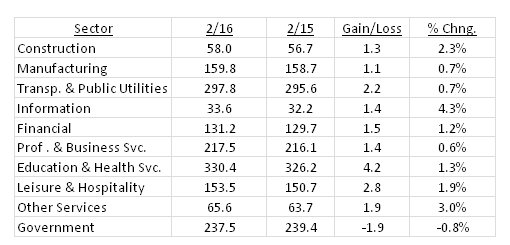
• U.S. employment has been advancing at a rate of 1.9 percent over the
12-month period ending in February; Connecticut's employment growth was 0.9
percent for the same period.
• Connecticut's unemployment rate was 5.5 percent in February; the national
unemployment rate was 4.9 percent. Connecticut's unemployment rate has continued
to decline from a high of 9.5 percent in October 2010.
• There were 104,600 unemployed job seekers in Connecticut in February. A low of
36,500 unemployed workers was recorded in October of 2000. The number of
unemployed workers hit a recessionary high of 177,200 in December of 2010.
![]()
• The Department of Labor reports that the private0sector workweek, not
seasonally adjusted, averaged 33.1 hours in February 2016, down three-tenths of
an hour from the same month a year ago (33.4 hours, -0.9 percent). Average
hourly earnings at $30.35, not seasonally adjusted, were up $1.21, or 4.2
percent, from the February 2015 hourly earnings estimate. The resulting average
private-sector weekly pay was calculated at $1,004.59, up $31.31, or 3.2 percent
higher than a year ago. The Department of Labor notes that the strong growth
rates in earnings are not supported by other data sources, specifically the
Quarterly Census of Employment and Wages.
• The 12-month percent change in the Consumer Price Index for All Urban
Consumers (CPI-U, U.S. City Average, not seasonally adjusted) in February 2016
was 1.0 percent.
• The graph below shows the monthly percent change from the prior year in
Connecticut private-sector weekly earnings. Since the start of Fiscal Year 2015,
Connecticut has experienced positive growth in wages, although still below the
pre-recession growth levels.
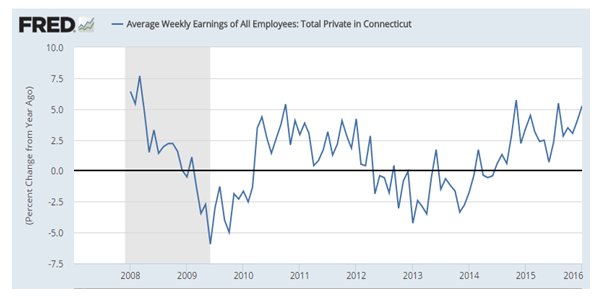
• Connecticut ranked 39th nationally in income growth for the 2015 calendar
year based on personal income statistics released by the Bureau of Economic
Analysis on March 24. Personal income grew by 3.1 percent in the state during
2015. Connecticut ranked number one in per capita personal income at $66,972.
• The chart below shows the trend in Connecticut personal income, which has yet
to attain its past expansionary strength. Data for the first quarter of 2016
will be released on June 22.
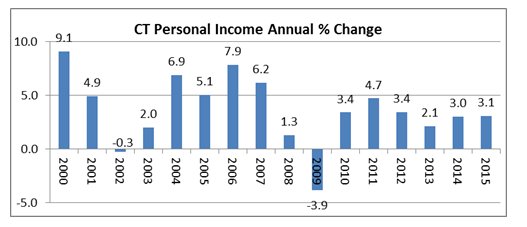
• In 2015, Connecticut ranked number two in the nation in the number of
households per capita with investable assets of over $1 million. According to
Phoenix Global Wealth Monitor, 100,996 or 7.3 percent of households in the state
were millionaires. The state also held this ranking in 2014.

• According to a March 8 release by the Warren Group, January sales were 24.9
percent above the same month last year in the state. Connecticut recorded 1,717
single-family home sales in January 2016, the most sales to start a year since
January 2007. Condominium sales were also strong, growing 16 percent from last
January.
• Single-family home prices in Connecticut were stable at a median selling price
of $230,000. Condominium prices fell to a median of $150,000, which is 11.2
percent lower than last January.
• The table below shows sales activity in January 2016 by county as compared to
last January.


• New housing permits in the state dropped in January. Overall permits have been on an upward path since the end of the recession, although not reaching the pace of prior post-recession activity. The shaded areas on the graph below represent recessions.

• Nationally, U.S. existing home sales fell sharply in February. The National Association of Realtors said existing home sales dropped 7.1 percent to the lowest level since November. Sales fell across the country, including a 17.1 percent plunge in the U.S. Northeast.
Consumers
• The Commerce Department reported that retail sales fell 0.1 percent in
February. Overall sales were revised sharply lower in January, from a
0.2-percent gain to a drop of 0.4 percent.
• Sales were generally weak across the board: Auto dealers, electronics and
appliance stores, grocery stores and department stores all reported lower sales.
Lower gas prices sent gas station sales down 4.4 percent. In February, eight of
13 major retail categories showed declines, indicating the drop was also
broad-based. Shoppers did spend more in some areas: Sales at home supply,
clothing, and sporting goods stores all rose. Sales at restaurants and bars also
jumped 1 percent.
• Core sales, which exclude such categories as autos, gasoline stations and
building materials, were unchanged in February after a revised 0.2-percent
increase in January. The preliminary January gain had shown a 0.6-percent gain.
• After a solid increase in consumer credit of 7.3 percent in December, credit
fell back in January, rising at a 3.6-percent rate. Revolving credit dropped 1.3
percent, while non-revolving credit posted a gain of 5.4 percent.

Business and Economic Growth
• According to the March 25 third estimate by the Bureau of Economic Analysis
(BEA), U.S. GDP increased at an annual rate of 1.4 percent in the fourth quarter
of 2015. The second estimate had recorded growth of 1 percent. The adjustment to
GDP was largely due to an upward adjustment to consumer spending. Growth of 2
percent was posted in the third quarter.
• Despite the improvement in GDP, there is a reason for some concern. Corporate
profits dropped 11.5 percent in the fourth quarter from the same period a year
ago. This was the largest decline since a 31-percent collapse at the end of 2008
during the height of the financial crisis.
• For 2015 as a whole, earnings fell 3.1 percent, the most in seven years. Much
of this decline is due to the energy-sector impact of depressed oil prices as
well as a strong U.S. dollar that has negatively impacted manufacturing exports.
However, economists have noted that, even adjusting for these factors, there
appears to be a more generalized profit-margin squeeze driven by tighter labor
markets, rising wages and weak productivity.
• The first-quarter 2016 corporate earnings outlook remains negative with S&P
500 companies expected to post an 8.3-percent decline in profits from the same
period a year ago. Analysts at the beginning of 2016 had been projecting a
modest 0.3-percent earnings increase.
• Unlike previous quarters where the profit decline was largely confined to
energy and, to a lesser extent, materials, the profit declines are widespread.
Just three of the S&P 500's 10 sectors are projected to show growth for the
quarter.
• New orders for manufactured durable goods (goods with a life of three years or
more) decreased in February by $6.6 billion or 2.8 percent to $229.4 billion,
according to a March 24 Census Bureau release. This decrease, down three of the
last four months, followed a 4.2-perent January increase. Excluding
transportation, new orders decreased 1 percent. Excluding defense, new orders
decreased 1.9 percent.
• The service sector, the biggest part of the U.S. economy, expanded slowly in
March after contracting in February. The seasonally adjusted Markit U.S.
Services Purchasing Managers Index (PMI) registered at 51.0 in March, up from
49.7 in February. This reading indicates only a marginal expansion of service
sector activity. The average reading for the first three months of 2016 was
51.3, which was the slowest quarterly pace of expansion since the third quarter
of 2012. At the same time, the latest data indicated that new business levels
expanded at the weakest pace since the survey began in October 2009.
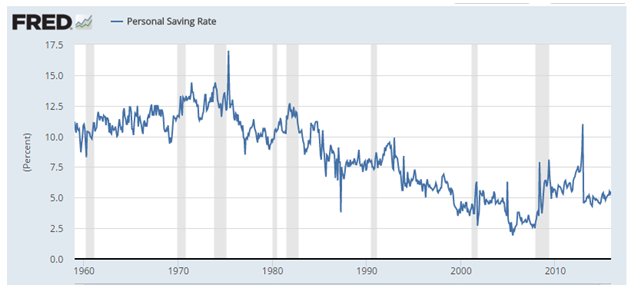
• In Connecticut, the business trends tracked by the Department of Labor – which include housing permits, exports, gaming slots, visits to major attractions, air passenger count, CT manufacturing production index, and weekly hours – had been on an upward trend as 2015 ended.

Stock Market
• Estimated and final income tax payments account for approximately 40
percent of total state income tax receipts. These payments show a correlation to
activity in equity markets relating to capital gains.
• At the end of February, year-to-date estimated tax payments for Fiscal Year
2016 were negative as compared to last fiscal year. Over the past 11 fiscal
years, estimated and final payments moved in opposite directions twice. The
current negative trend in estimated payments through the February raises
concerns about final April receipts, even though there is a current positive
trend on a small percentage of the total anticipated collections.
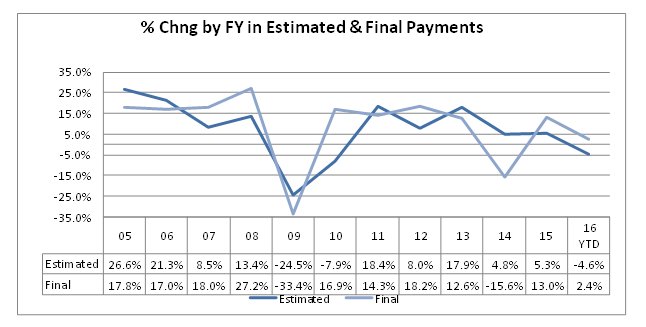
• According to a report released by the Federal Reserve, Americans lost
nearly $1.2 trillion in wealth in the third quarter of 2015 as the stock market
dropped. This equity decline contributed to one of the largest losses in
household net worth since the economic recovery began. To put the loss in
perspective, in the third quarter total real GDP was $16.4 trillion.
• Corporate equities lost $2.3 trillion over the quarter. Major stock indexes in
the U.S. plunged sharply in late August of 2015. Market volatility has continued
to erode gains that occurred after the August correction.
• The graphs below show the year-to-date movement in the DOW and the S&P
respectively.
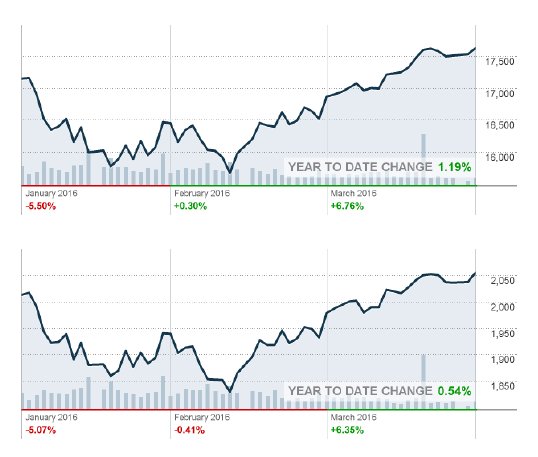
***END***
